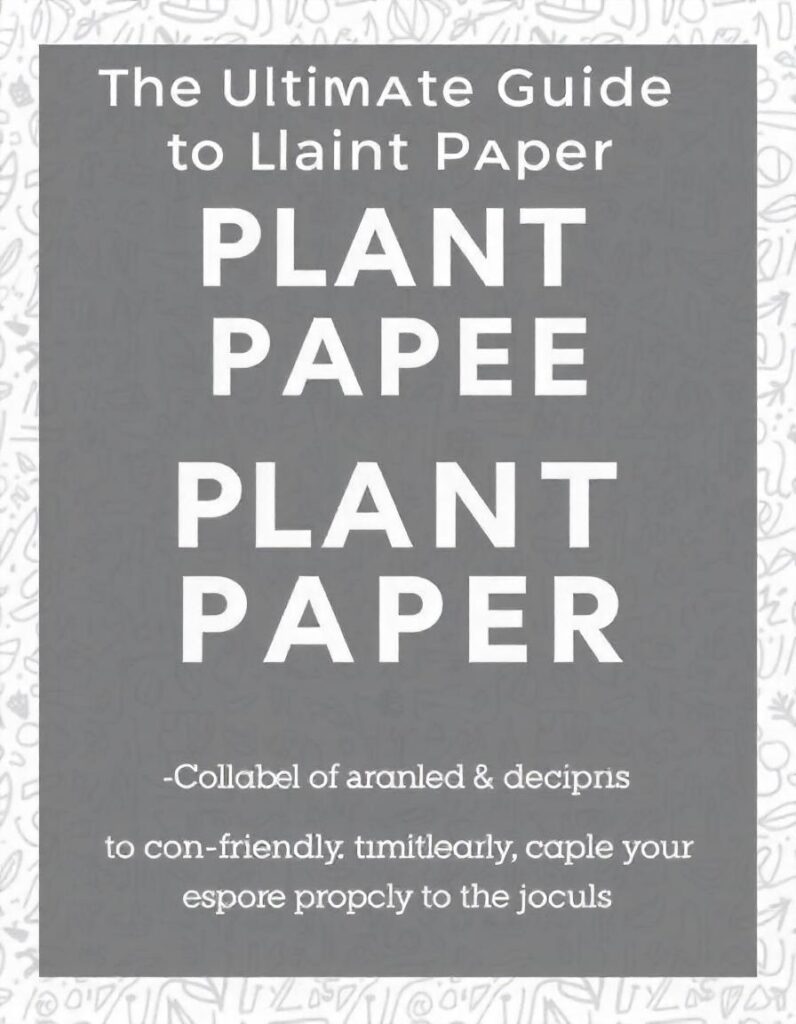The Ultimate Guide to Plant Paper: An Eco-Friendly Alternative to Traditional Paper
As the world becomes more environmentally conscious, people are increasingly seeking sustainable alternatives in their everyday lives. One such innovation is plant paper, an eco-friendly alternative to traditional paper that has garnered attention for its potential to reduce deforestation, lower carbon footprints, and support biodiversity. This guide will explore what plant paper is, its benefits, how it’s made, and why it might be the future of paper production.
Table of Contents

What is Plant Paper?
Plant paper, often referred to as tree-free paper, is made from various plant fibers other than wood. Traditional paper production relies heavily on trees, contributing to deforestation and environmental degradation. Plant paper, on the other hand, uses renewable plant sources such as bamboo, hemp, sugarcane bagasse, and agricultural waste. These materials are processed into a pulp that can be transformed into paper products.
Common Materials Used in Plant Paper Production
- Bamboo: Bamboo is one of the fastest-growing plants in the world, making it an excellent renewable resource. Bamboo fibers are strong, durable, and suitable for making high-quality paper.
- Hemp: Hemp has been used for centuries to produce paper. It requires less water and pesticides compared to traditional crops, and its fibers are stronger than those from trees, producing durable paper.
- Sugarcane Bagasse: This is the fibrous residue left after sugarcane is crushed to extract juice. Rather than being discarded as waste, it can be repurposed to make paper, reducing waste and providing a sustainable alternative to wood pulp.
- Agricultural Waste: Various agricultural byproducts, such as straw, corn husks, and banana stems, can be used to make paper. This repurposing helps reduce agricultural waste and makes paper production more sustainable.
Benefits of Plant Paper
- Reduced Deforestation: The most significant advantage of plant paper is that it does not rely on cutting down trees, which helps reduce deforestation. This is crucial for preserving forests, which play a vital role in absorbing carbon dioxide, providing habitats for wildlife, and regulating the Earth’s climate.
- Lower Carbon Footprint: Plant paper production typically requires less energy and water than traditional paper production. Additionally, using renewable plant materials reduces the carbon emissions associated with paper manufacturing.
- Biodiversity Conservation: By decreasing the demand for wood, plant paper helps preserve forests and their biodiversity. Forest ecosystems support countless species, and protecting them is essential for maintaining ecological balance.
- Waste Reduction: Plant paper can be made from agricultural byproducts, which would otherwise go to waste. Repurposing these materials reduces the environmental impact of waste disposal and promotes a circular economy.
- Biodegradable and Recyclable: Like traditional paper, plant paper is biodegradable and recyclable. This ensures that even after use, it has minimal impact on the environment, contributing to sustainable waste management practices.
How is Plant Paper Made?
The process of making plant paper is similar to traditional paper production, but with plant fibers instead of wood pulp. Here’s a simplified breakdown of the process:
- Harvesting: Plant fibers such as bamboo, hemp, or agricultural waste are harvested. In the case of agricultural byproducts, the waste materials are collected after the primary crop has been processed.
- Pulping: The plant fibers are broken down into a pulp through mechanical or chemical processes. This pulp is then mixed with water to create a slurry.
- Forming: The pulp slurry is spread out over a screen to form thin sheets of paper. The water is drained away, leaving behind a mat of plant fibers.
- Pressing and Drying: The wet paper mat is pressed to remove excess water and then dried. The final result is a sheet of plant-based paper ready for use.
- Finishing: The dried paper can be cut, rolled, or otherwise processed into various paper products, such as notebooks, packaging materials, or printing paper.
Applications of Plant Paper
Plant paper can be used in a wide range of applications, from everyday items like notebooks and stationery to specialized products like packaging and construction materials. Some specific uses include:
- Office Supplies: Plant paper is an excellent alternative for printing paper, notebooks, envelopes, and other office materials.
- Packaging: Plant-based paper is becoming popular for packaging, as companies look for sustainable ways to wrap and protect their products.
- Toilet Paper and Tissues: Some companies now offer tree-free toilet paper and tissues made from bamboo or other plant fibers, providing a sustainable option for consumers.
- Art and Craft: Artists and crafters are embracing plant paper for its unique textures and sustainability, using it in various creative projects.
Why Plant Paper is the Future
As the world shifts towards more sustainable practices, plant paper stands out as a promising solution. The environmental benefits of reduced deforestation, lower carbon emissions, and waste reduction make it a compelling alternative to traditional wood-based paper. Additionally, advancements in technology are making plant paper more affordable and accessible, paving the way for broader adoption across industries.
Consumers are increasingly aware of the environmental impact of their purchases and are seeking out eco-friendly alternatives. Businesses, too, are responding to this demand by adopting sustainable practices, including the use of plant paper for their products and packaging. This shift towards plant-based paper not only helps protect the environment but also supports innovation and the development of green industries.
Conclusion
Plant paper is a sustainable and eco-friendly alternative to traditional wood-based paper, offering numerous environmental benefits. By utilizing renewable plant fibers, reducing waste, and conserving forests, plant paper production plays a crucial role in promoting a greener future. As more consumers and businesses embrace sustainable practices, plant paper is poised to become a staple in the paper industry, contributing to a healthier planet for future generations.
This comprehensive guide outlines the basics and importance of plant paper, making it a valuable resource for individuals looking to make eco-conscious choices. The shift towards sustainable materials like plant paper reflects a growing global movement to protect the environment, conserve resources, and reduce the carbon footprint of everyday products.
